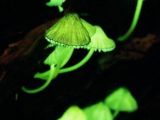Fungi can be found everywhere in some organic chemicals, from water to pastures and even in sand dunes. But for those forming mushrooms their favorite environment remains the soil of the forests, where the biggest diversity in species, sizes, shapes and colors is to be found.
Some species are poisonous, others are comestible, but all of them share one particularity: they lack chlorophyll and cannot use the sunlight to produce biochemicals, that's why they eat dead organic chemicals: logs and leaves which decompose, releasing their mineral salts for the forest soil.
Underground, mushrooms have a structure resembling a spider web called myceliium, which penetrates into the dead organic matter, or in the case of the parasite ones, into the tissues of the host. Some mushrooms are parasites on the trees, while others live in symbiosis with the trees' roots, a relation called mycorrhize: the mushrooms' mycelia offers the tree water and mineral salts and receives food.
When the underground mycelium has grown enough and the humidity is the required one, small buttons start to emerge from the soil (that's why mushrooms grow especially during the spring and fall). This one grows, and in Basidiomycota mushrooms (most of the cultivated ones) it forms a step and a cap with gills on the underside. These are the fruiting bodies.
Each cap can form up to 2 billion spores. The caps can be up to 20 cm (8 inch) in diameter and the color varies in different models of tawny, yellow, pink, orange, red, purple, brown till almost black. The caps can have varied shapes, and their surface can be smooth, slippery or velvet. There are mushrooms that radiate a pale bioluminescence, due to luciferin, the same chemical found in fireflies. The luminescence can be emitted by the mycelia or by the fruiting bodies, but only when they are young.
The honey fungus (Armillaria melea), a parasitic species, gives a yellowish-greenish light to the wood of the parasitized trees.
There is not a rule to say which species are comestible and which are not, and not all the vivid colored species are poisonous; many poisonous species are inconspicuous, and the poisonous ones blacken when broken.
In order to release the spores, the caps are tilted with two degrees to the ground. When they mature, the spores fall on the soil, and the slightest air current can carry them thousands of kilometers away. They can travel for months, they are resistant to extreme temperatures and when reaching a place with proper conditions, they germinate, forming new mycelia. Some spores are caught in a sticky substance, like in the case of the species Endothia parasitica, parasitic on chestnut trees. As they are sticky, a sole woodpecker carries a billion spores from one tree to another.
The fungus Rhizoppus arrhizus is known to recover metals from industrial waste waters. One gram of Rhizoppus can fix up to 58 milligrams of mercury, 104 mg of lead, and 221 mg of uranium. Other fungi are able to recover zinc and nickel.

 14 DAY TRIAL //
14 DAY TRIAL // 
